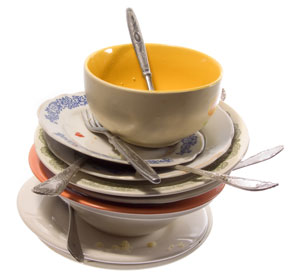 OK. We all love saving time, right? Of course we do. My kids do as well. In fact, everytime I ask them to help with any household task, they instantly slide into “time-saving-mode”. Which really just means that they look for shortcuts and ways to cut steps out of projects.
OK. We all love saving time, right? Of course we do. My kids do as well. In fact, everytime I ask them to help with any household task, they instantly slide into “time-saving-mode”. Which really just means that they look for shortcuts and ways to cut steps out of projects.
For example, when it comes to doing dishes, they routinely cut out the “scrubbing” step. We don’t have a dishwasher and so we end up standing at the sink every night after dinner. And since this is so boring, the kids have found that they can skip the scrubbing step in order to cut a lot of time out of the job. They run their little fingers over the glasses and the forks in a half-hearted cleaning effort and then they rinse like champions.
And then, days later, we have a guest over and inevitably, the guest needs a glass of water or something. And I get a cup out of the cupboard and stifle a scream when I see a spaghetti noodle, crispy and razor sharp, draped across the cup like a worm on the sidewalk in the sun. I try to hide the glass and reach for another only to find a hunk of hamburger stuck to the next one. Quickly, I toss that one behind my back and reach for a third glass only to find that it’s lined with sticky, leftover Mountain Dew.
I wish I were exaggerating, but I’m not. It’s really embarrassing. And it proves the point that saving time by skipping steps isn’t always the best plan.
And that’s brings me to the paint point: Many of us want to save time on a paint project and one of the easiest ways to do that is to cut out the primer step. After all, it’s just a time-consuming, boring, and labor-intensive step that serves no real purpose, right? Why put 1 coat of primer and 2 coats of finish when we could just do 2 coats of finish? Can’t we save time by just skipping the primer and going straight to paint?
It’s a great question and we’re going to answer it in chunks. First, let’s start by pointing out that paint and primer are fundamentally different products which serve fundamentally different purposes. Yes, they look similar in the can and they’re applied the same, but a lot of the similarities end there. Paint is designed to take tint and lock that color in a paint film that offers you a sheen (should you want one), scrub resistance, durability, and protection from the elements. Paint is designed to look beautiful and provide you with the durability you need on any given surface.
Primer, on the other hand is made to seal, to adhere, to block a stain, to resist rust, and for a wide variety of other specific situations:
So, using a finish paint on bare drywall, for example, is going to cause problems. Yes, you’re skipping the primer step, but in that instance, you’ll find that your more expensive finish paint is soaking into the surface unevenly. If you used a finish with a sheen (anything other than flat), you will notice that the wall has dull areas (where the paint soaked in) and shiny areas (where it didn’t). Subsequent coats will not completely even this out and you have the potential to produce a wall that has shiny spots that are visible no matter how many coats you apply. A specific drywall primer like RepcoLite’s Quick Seal would resolve this problem for less money!
Using a finish paint over a ceramic tile backsplash is only going to result in sorrow when you find your paint peels off whenever you bump the wall. Again, a bonding primer like Stix from Insul-X, would take care of the problem!
The bottom line is this: skipping the primer may save you some time, but it will likely cause a larger number of problems that are much more complicated and expensive to deal with. If you’re unsure if the project you’re tackling requires a primer, let us help! Just ask at any RepcoLite or Port City Paints location and we’ll let you know the best way to proceed.
Now, of course, the next issue that comes up revolves around the paint and coating industry’s newest innovation: Paint and Primer All-In-One products! All this talk about primers goes out the window when you’re using one of these miracle all-in-one products, right? Well . . . not so fast. We’ll deal with that in the next post!

